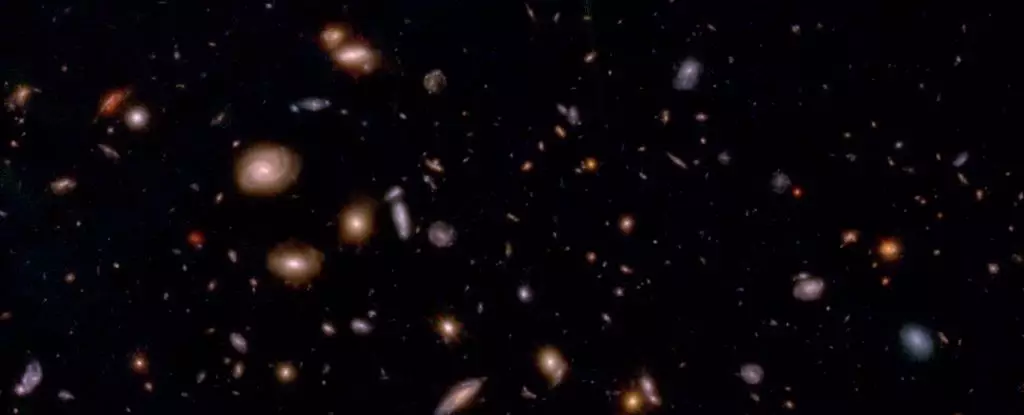As we gaze into the vast expanse of the universe, an intriguing enigma emerges: the peculiar rotational patterns of galaxies. While the grand tapestry of the cosmos contains an immense variety of shapes, sizes, and formations, recent surveys reveal that a surprising majority of these galaxies spin in the same direction. This observation poses a significant conundrum to astronomers, fundamentally challenging our established models of cosmic behavior. The question lingers: Could the cosmos be orchestrating a grand symphony that our current understanding is simply unable to decode?
The standard inclination in cosmology suggests that galaxies should display a random distribution regarding their rotational directions—yet this is not what we observe. Instead, the data indicates a striking asymmetry, hinting at a profound gap in our knowledge about the universe’s evolution and the underlying forces at play. Lior Shamir, an astronomer from Kansas State University, has surfaced as a crucial figure in untangling this mystery, illuminating the way our interpretation of galactic spins could reshape our entire cosmic framework.
Theories in Collision: The Rotation Riddle
Shamir presents two tantalizing hypotheses regarding the observed directional spin of galaxies. The first is a bold proposition: the universe may have been born with a rotation. This theory aligns with radical cosmological ideas, such as black hole cosmology, suggesting that the entire universe exists within a cosmic black hole. If true, this would imply that existing models are not just incomplete—they may need wholesale re-evaluation. Imagine a cosmos born from a massive spinning entity, swirling in chaos yet forming the structured galaxies we witness today.
Contrastingly, the less thrilling second hypothesis suggests that the rotational asymmetry we see might merely reflect our own galaxy’s motion. Initially, it may seem plausible that the Milky Way’s rotation could skew our perception of the universe’s structure, introducing an element of illusion. Shamir’s findings provoke thought: could our position in the cosmos mislead us about the nature of galactic spins? This question is alarmingly reminiscent of a broader critique within science—how often do we project our local motions onto a cosmological scale, thereby distorting our understanding?
Data-Driven Discoveries: From JWST to the Cosmic Canvas
In a significant leap towards understanding this cosmic ballet, Shamir analyzed data collected from the James Webb Space Telescope (JWST) Advanced Deep Extragalactic Survey (JADES). The study encompassed 263 galaxies whose light took between five to ten billion years to reach us, revealing vital data about their rotations. Through rigorous quantitative analyses of these galaxies’ shapes, Shamir discovered a conspicuous imbalance: 105 galaxies rotate counterclockwise while 158 spin clockwise.
To the untrained eye, these numbers may not seem shocking, yet they defy the cosmological principle of isotropy, which postulates that the universe should show uniformity in all directions. As Shamir aptly points out, even casual observers could notice this disparity. The implications are monumental; a deviation from the anticipated 50-50 split in galaxy rotation raises troubling questions about the underlying forces governing celestial motions.
Challenging Cosmological Norms
The implications of Shamir’s research extend beyond merely quantifying rotational direction. The asymmetry discovered is a clarion call for the scientific community to grapple with the notion that our perceptions and the frameworks we use could be fundamentally flawed. If our interpretations about galaxy spins arise from misconceptions influenced by our local galactic environment, then we may stand at the threshold of a scientific renaissance.
Consider the potential consequences of reevaluating our distance measurements in the universe. A recalibration might not only illuminate the mechanisms governing cosmic expansion but could also offer insight into dark matter and its role in shaping these galactic spins. What if each galaxy’s direction encapsulates secrets about the cosmic web that binds us? Understanding these patterns might provide the keys to unlock the universe’s deepest mysteries.
The Quest for Knowledge: A Cosmic Journey
Though pondering the possibility that the universe is more complex than our current models suggest can be daunting, it is also a captivating pursuit. The unpredictability inherent in scientific discovery can lead to exhilarating revelations, pushing the boundaries of human understanding. As researchers like Shamir persist in their investigations, the celestial stage continues to transform, inviting us to adapt and grow our comprehension of the cosmos.
This captivating journey into the heart of cosmic structure offers much more than an academic puzzle; it beckons us to reflect on our place within an inherently unpredictable universe. Embracing the unknown is the catalyst for scientific progress, fueling our quest for knowledge amidst the stellar backdrop of existence.

